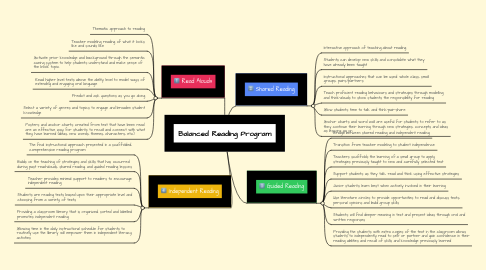Balanced Reading Program
by Michele Jacobs

1. Read Alouds
1.1. Thematic approach to reading
1.2. Teacher modeling reading of what it looks like and sounds like
1.3. Activate prior knowledge and background through the semantic cueing system to help students understand and make sense of the book topic
1.4. Read higher level texts above the ability level to model ways of extending and engaging oral language
1.5. Predict and ask questions as you go along
1.6. Select a variety of genres and topics to engage and broaden student knowledge
1.7. Posters and anchor charts created from text that have been read are an effective way for students to recall and connect with what they have learned (ideas, new words, themes, characters, etc)
2. Independent Reading
2.1. The final instructional approach presented in a scaffolded, comprehensive reading program
2.2. Builds on the teaching of strategies and skills that has occurred during past read-alouds, shared reading, and guided reading lessons
2.3. Teacher provides minimal support to readers to encourage independent reading
2.4. Students are reading texts based upon their appropriate level and choosing from a variety of texts
2.5. Providing a classroom library that is organized, sorted and labelled promotes independent reading
2.6. Allowing time in the daily instructional schedule for students to routinely use the library will empower them in independent literacy activties
3. Shared Reading
3.1. Interactive approach of teaching about reading
3.2. Students can develop new skills and consolidate what they have already been taught
3.3. Instructional approaches that can be used: whole class, small groups, pairs/partners
3.4. Teach proficient reading behaviours and strategies through modelling and think-alouds to show students the responsibility for reading
3.5. Allow students time to talk and think-pair-share
3.6. Anchor charts and word wall are useful for students to refer to as they continue their learning through new strategies, concepts and ideas as lessons go on
4. Guided Reading
4.1. Bridge between shared reading and independent reading
4.2. Transition from teacher modeling to student independence
4.3. Teachers scaffolds the learning of a small group to apply strategies previously taught to new and carefully selected text
4.4. Support students as they talk, read and think using effective strategies
4.5. Junior students learn best when actively involved in their learning
4.6. Use literature circles to provide opportunities to read and discuss texts, personal opinions and build group skills
4.7. Students will find deeper meaning in text and present ideas through oral and written responses
4.8. Providing the students with extra copies of the text in the classroom allows students to independently read to self or partner and gain confidence in their reading abilities and recall of skills and knowledge previously learned


